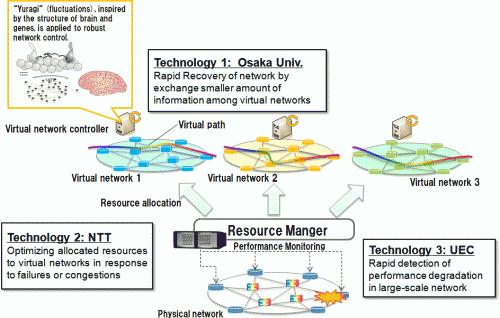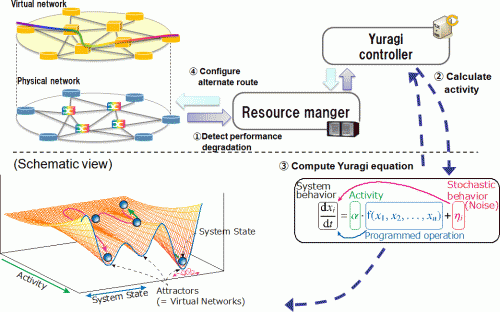World's first development of bio-inspired 'Yuragi' algorithm for network virtualization

Nippon Telegraph and Telephone Corporation, Osaka University, and The University of Electro-Communications have developed a biologically-inspired "Yuragi (fluctuations)" algorithm for virtual network control technology. By deploying the newly developed technology, researchers can provide the rapid recovery of a network service in case of unexpected disasters or congestions.
At the upcoming JGN-X demonstration event sponsored by the National Institute of Information and Communications Technology (NICT), from February 5-7, 2013, researchers plan to demonstrate a congestion avoidance experiment using the developed technology. In the demonstration, video streaming traffic will be transferred from Okinawa to Sapporo on JGN-X, and developers will confirm the rapid recovery from a congestion caused by additional background traffic.
The recent rapid spread of cloud computing and emerging applications such as M2M/IoT has led to sudden traffic demand changes. As multiple logical networks are operated on a common physical network infrastructure, it has become increasingly important to operate such networks in the stable manner in order to maintain the stability of each service from the view point of BCP (business continuity planning).
To cope with these issues, multiple virtual networks, each of which corresponds to a service network or a customer network, should be constructed on a common physical network infrastructure; at the same time, those networks should support the customization of network function and operation policies. Moreover, it is also necessary to accommodate unexpected sudden traffic demand changes imposed by cloud computing or emerging applications.
Thus, the research and development of a network virtualization technology based on the Yuragi algorithm, which is originally proposed by Osaka University, under the collaboration of NTT, Osaka University, and UEC.

As each virtual network is able to autonomously compute nearly optimal route or network topology, the computation time is much faster compared to conventional optimization technologies and ensure adaptability to unexpected environmental changes. This enables rapid network recovery that satisfies practical requirements in case of a large-scale disaster or congestion. Osaka University carried out the theoretical study and developed control algorithms, while NTT improved control algorithm to be applied for an operational network and developed network control server to demonstrate the developed technology.
Osaka University developed a scheme for stabilizing the behavior of multiple virtual networks through the feedback of other virtual network status, while NTT developed a resource access mechanism that isolates the behavior of a specific virtual network from others. Those two technologies enable efficient network resource usage by adequately distributing traffic load. The LLR scheme keeps the information of top-rank links, ordered by link load, in a ranking table. Only the information that relates to the ranking table is advertised. With the LLR scheme, the number of advertisements is 78% reduced, comparing to the general OSPF-TE network.
Provided by Nippon Telegraph and Telephone Corporation

















